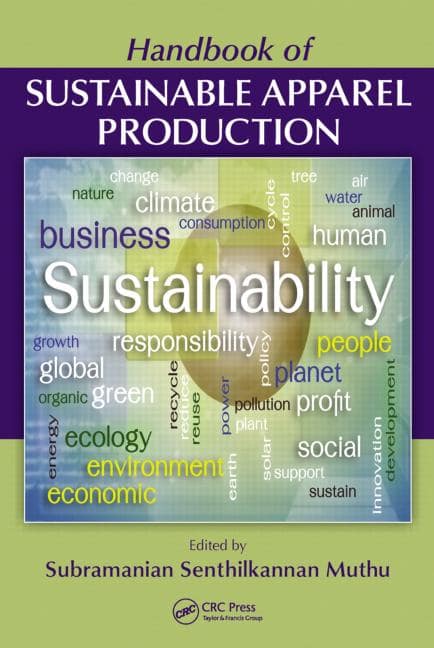
Contents
Preface………………………………………………………………………………………..ix
Editor………………………………………………………………………………………………….xi
Contributors…………………………………………………………………………………………….. xiii
Section I _Sustainable Textile Raw Materials and
Manufacturing Processes for Apparel Manufacture
Chapter 1 Water-Free Plasma Processing and Finishing of Apparel Textiles………………………….3
Kartick K. Samanta, Santanu Basak, S.K. Chattopadhyay, and T.N. Gayatri
Chapter 2 Sustainability in Clothing Manufacturing and Competitiveness: Is It a New
Mind-Set or a Paradox?………………………………………………………………………………….. 39
Wen Ying Claire Shih, and Konstantinos Agrafiotis
Chapter 3 Sustainable Flame-Retardant Finishing of Textiles: Advancement in Technology……. 51
Kartick K. Samanta, Santanu Basak, and S.K. Chattopadhyay
Chapter 4 Application of Biotechnology in the Processing of Textile Fabrics……………………….77
D. Saravanan, Thilak Vadicherla, K.P. Kannan, and S.N. Sreelakshmi
Chapter 5 Design and Development of Jute-Based Apparels………………………………………………97
Sanjoy Debnath
Chapter 6 Sustainable UV-Protective Apparel Textile…………………………………………………….. 113
Kartick K. Samanta, Santanu Basak, and S.K. Chattopadhyay
Section II _Environmental and Social Assessment of
Apparel Manufacturing
Chapter 7 Carbon Footprint of Textile and Clothing Products…………………………… 141
Sohel Rana, Subramani Pichandi, Shabaridharan Karunamoorthy,
Amitava Bhattacharyya, Shama Parveen, and Raul Fangueiro
Chapter 8 Environmental Impacts of Apparel Production, Distribution, and
Consumption: An Overview………………………………………………………………………….. 167
Kim Y. Hiller Connell
Chapter 9 Life Cycle Assessment Studies Pertaining to Textiles and the Clothing Sector……. 181
Shabaridharan Karunamoorthy, Sohel Rana, Rosina Begam, Shama Parveen,
and Raul Fangueiro
Chapter 10 Social Impacts of the Clothing and Fashion Industry……………………………207
Shanthi Radhakrishnan
Section III _Sustainability and Consumption Behavior of
the Apparel Industry
Chapter 11 Consumer Behavior and Its Importance in the Sustainability of the
Clothing Field…………………………………………………………………………………………….. 231
Jane McCann
Chapter 12 Consumer Behavior in the Fashion Field……………………………………………… 271
Kirsi Niinimäki
Chapter 13 Textile Sustainability: Major Frameworks and Strategic Solutions……………………..289
Arun Pal Aneja and Rudrajeet Pal
Section IV Assessment of Sustainable Apparel Production
Chapter 14 Eco-Parameters and Testing of Sustainable Textiles and Apparels……………………..309
Shanthi Radhakrishnan
Chapter 15 Functional Aspects, Ecotesting, and Environmental Impact of Natural Dyes……… 333
L. Ammayappan and Seiko Jose
Chapter 16 Test Methods Related to Characteristics, Performance, and Ecological and
Safety Parameters of Textiles………………………………………………………………………… 351
Luis Almeida
Chapter 17 Environmental Communication and Green Claims of Textile Products……………… 375
Shanthi Radhakrishnan
Chapter 18 Supplier Assessment in Global Apparel Supply Chains…………………………………….399
Shams Rahman and Aswini Yadlapalli
Chapter 19 Sustainable Measures Taken by Industry Affiliates, Nonprofit Organizations,
and Governmental and Educational Institutions………………………………………………. 419
Thilak Vadicherla and D. Saravanan
Section V Sustainability and Fashion
Chapter 20 Exploring a Framework for Fashion Design for Sustainability…………………………… 439
Alison Gwilt
Chapter 21 Fashion Industry and New Approaches for Sustainability…………………………………. 453
Kirsi Niinimäki, Esben Rahbek Gjerdrum Pedersen, Kerli Kant Hvass,
and Lisbeth Svengren-Holm
Chapter 22 Eco-Design/Sustainable Design of Textile Products………………………………………… 475
Thilak Vadicherla and D. Saravanan
Chapter 23 Fashion Industry and Sustainability……………………………………………………… 501
Shanthi Radhakrishnan
Index……………………………………………………………………………………………………….. 531
Preface
Since the last decade, “sustainability” has been one of the frequently heard terms in any industrial segment and has become a hot-button societal issue. The apparel sector, one of the important industrial sectors, cannot exclude sustainability, which is an important part of the agenda in the range of activities on which the apparel sector must focus. Sustainability and its developments are not new to the apparel sector, and it is becoming increasingly popular these days. Perhaps achieving sustainability in the clothing and apparel sector might look like an ambitious aspect, but it is doable. Since the supply chain is rather long, people do doubt its capabilities; however, many approaches are being followed to achieve sustainability. Owing to the longer and massive supply chain in the apparel industry, the assessment and implementation of sustainable measures in this industry are complex, and they cannot be denied. Nevertheless, striving efforts, cooperation, and collaboration from various members involved in the entire apparel supply chain make the complex task practically possible.
Sustainability in apparel production is a vast topic and it has many facets. This handbook divides this wide topic into five sections, and in each section, very important aspects are dealt with in dedicated chapters, written by subject experts. Section I (Chapters 1–6) is dedicated to sustainable raw materials and manufacturing processes and technologies that can pave the way toward sustainability in apparel production. Section II (Chapters 7–10) is earmarked to deal with an important aspect: the environmental and social impacts of apparel production and its assessment.
Chapters 11–13 in Section III revolve around discussions pertaining to the sustainability and consumption behavior of the apparel industry. The assessment of sustainability aspects and parameters is an important subject, and various topics come under this umbrella. Hence, Section IV (Chapters 14–19) is dedicated to this lengthy topic. Section V (Chapters 20–23) is earmarked to detail the design aspects, particularly sustainable design/eco-design, and new approaches to fashion sustainability.
All the important aspects, including even very minute details pertaining to sustainable apparel production, have been collated in this handbook, presented in the 23 chapters. I thank all the chapter contributors for their earnest efforts in successfully bringing out this handbook with the enriched technical content. I am very confident that the readers will benefit from the imperative details presented here pertaining to sustainable apparel production. The handbook will undoubtedly become an important reference for researchers and students, industrialists, and sustainability professionals working in the apparel sector.
